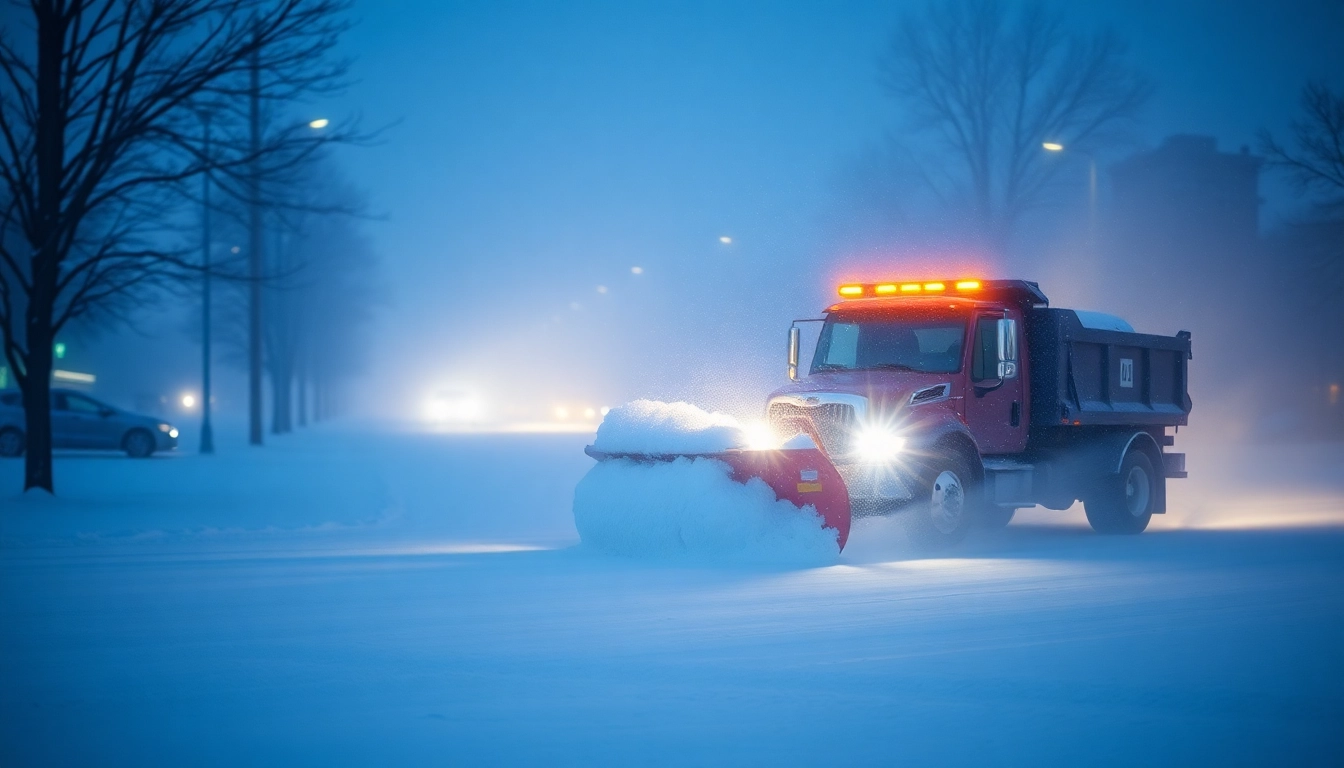Understanding the Basics of Snow Plowing
What is Snow Plowing?
Snow plowing is the process of clearing snow from surfaces such as roads, driveways, and parking lots using specialized vehicles equipped with plow blades. This practice is essential during winter months, especially in regions that experience heavy snowfall. The primary goal of snow plowing is to ensure safe passage for vehicles and pedestrians by removing accumulated snow from surfaces.
How Snow Plowing Differs from Snow Removal
While often used interchangeably, snow plowing and snow removal refer to two distinct processes. Snow plowing involves pushing snow off a surface and typically redistributing it to adjacent areas. This method may leave some snow behind, known as ‘snow ridges,’ especially if the snow is heavy. Conversely, snow removal entails completely removing the snow from a property and transporting it away, which is especially common in urban settings where space is limited. Such practices not only ensure safety but also aid in effective management of snow-related challenges in residential and commercial areas.
The Importance of Snow Plowing for Road Safety
Snow plowing is vital for maintaining road safety during winter. By promptly removing snow, municipalities can reduce the risks of accidents caused by slippery roads. Roads that are not adequately plowed can become hazardous, affecting traffic flow and increasing the likelihood of collisions. Moreover, emergency services need quick access to roads following a snowfall, making efficient snow plowing crucial for community safety.
Best Practices for Effective Snow Plowing
Choosing the Right Snow Plow Equipment
Selecting appropriate snow plow equipment is paramount for efficient operations. There are various types of snow plows available, including straight blades, V-blades, and even rotary plows, each suited for different snow conditions and clearing needs. Ensure that the selected equipment is compatible with the vehicle’s capacity and the expected snowfall intensity. Operators should also consider features like hydraulic adjustments for blade angles and heights, which can significantly impact plowing efficiency.
Planning Efficient Plowing Routes
Strategic planning is essential for optimizing plowing routes. These routes should consider factors such as road hierarchy, traffic patterns, and snow accumulation areas. Regularly updating plowing routes based on past snowfall data can help improve efficiency and reduce operational costs. Additionally, taking into account other service needs, like salting and sanding, allows for a comprehensive approach to winter road maintenance.
Tips for Maximizing Plowing Efficiency
To enhance plowing efficiency, operators should follow several tips:
- Regular Maintenance: Ensure that snow plow equipment is well-maintained and inspected before the season starts to prevent breakdowns during operations.
- Monitor Weather Conditions: Staying informed about upcoming weather patterns enables proactive planning and deployment of resources.
- Utilize Technology: Employ GPS tracking and route management software to monitor plow movements and optimize routes in real-time.
- Implement Communication Systems: Create clear communication channels among plow operators, ensuring everyone is updated on weather changes, plowing status, and emergency protocols.
Safety Tips for Snow Plowing Operations
Essential Safety Gear for Operators
Safety gear is critical for snow plow operators. Essential items include:
- High Visibility Clothing: Wearing bright, reflective clothing helps increase visibility in low-light conditions.
- Warm Layers: Proper layers of clothing are necessary to combat the freezing temperatures.
- Protective Footwear: Use insulated, waterproof boots to protect against cold and wet conditions.
- Head and Eye Protection: Helmets and goggles should be worn to protect against flying snow and debris.
How to Avoid Common Snow Plowing Hazards
Many hazards can arise during snow plowing, including slips, vehicle accidents, and equipment malfunctions. Operators should be vigilant and trained to recognize and mitigate these risks. Important safety measures include:
- Maintain a Safe Distance: Keep a safe distance from other vehicles to avoid collisions.
- Acknowledge Blind Spots: Operators must be aware of and frequently check blind spots while maneuvering.
- Follow Safe Speed Limits: Plowing should be done at safe speeds to maintain control and response capability.
Emergency Protocols During Heavy Snowfall
Heavy snowfall can create emergency situations that require immediate action. Operators should establish protocols that involve:
- Immediate Communication: Quickly inform relevant authorities if plowing operations are hindered by extreme weather conditions.
- Safety Check Procedures: Regularly check equipment for functionality and readiness during long shifts.
- Emergency Contact Lists: Maintain up-to-date contact lists for team members and emergency services for rapid response.
Understanding Costs Associated with Snow Plowing
Average Costs for Residential Snow Plowing Services
The cost of residential snow plowing varies significantly based on the service provider, geographic location, and the scope of work. On average, homeowners can expect to pay between $45 to $160 per visit or around $700 to $1,000 for a seasonal contract. Factors such as the size of the driveway, the amount of snow, and whether additional services like salting are needed will influence final costs.
Factors Influencing Snow Plowing Pricing
Several key factors affect the pricing of snow plowing services:
- Location: Urban areas often command higher prices due to demand and operational costs.
- Service Frequency: Regular service agreements can lower the cost per visit compared to one-time services.
- Time of Service: Plowing late at night or during a snowstorm may incur additional fees.
Ways to Budget for Winter Snow Plowing
Budgeting effectively for snow plowing requires planning and assessment of potential expenses. Homeowners should consider:
- Seasonal Budgeting: Set aside a specific amount each month in anticipation of winter costs.
- Emergency Fund: Maintain a fund to cover unexpected heavy snowfall that may exceed normal service costs.
- Researching Providers: Comparing prices and services from multiple snow plowing companies can help assess the best value.
Future Trends in Snow Plowing Technology
Innovations in Snow Plow Designs
The snow plowing industry is experiencing rapid advancements in technology and design. Future snow plows are being designed with improved aerodynamics, enhanced materials for durability, and integrated technology for seamless operation. For instance, plows that automatically adjust blade height and angle based on snow density are becoming more common, allowing for more effective clearing and reduced wear on equipment.
The Role of Automation in Snow Plowing
As automation technology continues to evolve, its incorporation into snow plowing operations is becoming increasingly feasible. Autonomous snow plows can operate without human intervention, programmed to follow predetermined routes and make adjustments based on real-time conditions. This innovation not only boosts efficiency but also allows for better resource allocation, as human operators can oversee multiple plows remotely.
Eco-Friendly Snow Plowing Solutions
The push for sustainability in all industries is leading to the development of eco-friendly snow plowing solutions. From biodegradable de-icing agents to electric snowplows that reduce emissions, environmentally friendly practices are making headway in this field. These innovations help reduce the ecological footprint of snow removal while maintaining public safety during winter months.



